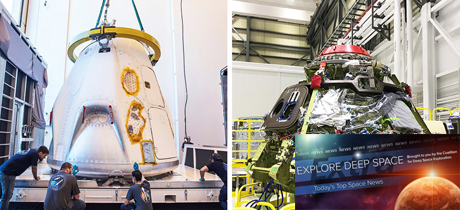In Today’s Deep Space Extra… NASA’s Commercial Crew Program is close to restoring U.S. human spacecraft launches. Flight assignments are to be announced on Friday. NASA’s recently launched Transiting Exoplanet Survey Satellites (TESS) has started its search for extra solar planets around the nearest stars.
Human Space Exploration
NASA, commercial partners progress to human spaceflight home stretch
NASA/Commercial Space (7/27): NASA’s Commercial Crew Program and its partners, Boeing and SpaceX, hold the key to a new era of human private sector space transportation. All three are striving to meet the milestone that will enable the U.S. to begin launching astronauts for the first time since NASA’s shuttle fleet was retired July 2011.
NASA names Jody Singer acting Marshall Space Center director
Huntsville Times (7/27): Jody Singer, on an acting basis, will succeed retiring Todd May as the director of NASA’s Marshall Space Center, which is home to the agency’s Space Launch System (SLS) development and much of the International Space Station science operations. Singer, who moves up from Marshall’s deputy director, began her career in 1985 as an engineer and worked in the space shuttle program for 25 years.
Space News (7/27): Astronaut and Japan Aerospace Exploration Agency vice president Koichi Wakata sees sustained interest in low Earth activities as NASA and its partners weigh the future of the International Space Station. Japan, too, intends to participate in a human tended, Lunar Orbital Platform-Gateway (LOP-G).
Space Science
TESS begins hunt for other earths, opening new chapter in exoplanet research
AmericaSpace.com (7/27): NASA’s recently launched Transiting Exoplanet Survey Satellite (TESS) initiated science operations on July 25. The orbiting space telescope will soon inherit the Kepler missions extra solar system planet search which began in 2009. Kepler is nearly out of fuel. TESS, however, will search stars much closer to Earth for evidence of planets orbiting in the “habitable zone.”
Ancient craters on Mars reveal how the planet’s tilt has changed over time
Science (7/27): Like the Earth, Mars leans over as it orbits the sun, but more. The Earth’s 23.5 degree North Pole list gives us seasonal changes. Scientists report that on Mars this lean, or “obliquity,” has changed through history, shifting between 10 degrees and 30 degrees, compared to its current 25 degrees. Their findings are based on crater studies that suggest Martian obliquity changed in response to the gravitational influences of other planets. These changes likely influenced the status of subsurface water on Mars.
NASA statement on possible subsurface lake near Martian south pole
NASA/Jet Propulsion Laboratory (7/25): Last week in the journal Science, Italian researchers participating in the European Mars Express mission announced the discovery of a possible pool of liquid water beneath the Martian south polar cap. NASA’s Jet Propulsion Laboratory contributed to the development of the MARSIS radar sounder that provided data for the water claim. NASA chief scientist Jim Green terms the finding “intriguing” but notes that it warrants further study.
Boulders and a crater dot asteroid Ryugu in this spectacular up-close view
Space.com (7/28): Japan’s Hyabusa 2 asteroid sample return mission, launched in December 2014, arrived at its destination, Ryugu, in late June. Recent photos taken just 4 miles from the surface of the asteroid reveal a crater and bolder strewn terrain. NASA’s Osiris-Rex asteroid sample return mission is also growing closer to its destination, Bennu, with arrival planned for early December.
Moonrise, Moonset and Mars: Photos hit the high points at Mount Rainier
GeekWire.com (7/27): A full Moon and Mars, destinations for future human exploration, shared the night sky and shined brightly as July wound to a close.
Other News
NASA could be Israel’s ticket to space
The Hill (7/27): Israel recently joined other nations expecting to become a part of NASA’s deep space objectives, including the assembly of a human tended, Lunar Orbital Platform-Gateway (LOP-G). This op-ed suggests these nations also partner with the companies preparing for a growing low Earth orbit economy.
Public comments slam coastal Georgia spaceport proposal
Savannah Morning News of Georgia (7/29): Public comment in response to an FAA required Environmental Impact Statement challenges plans to construct a spaceport in Camden County, Georgia for small and medium rocket launches. Many of the comments express concerns over changes to wildlife environments. Supporters are backing prospects for economic development.
China launches new twin BeiDou-3 navigation satellites
Xinhuanet of China (7/29): China early Sunday launched the 33rd and 34th members of its Beidou global satellite navigation network atop a single Long March 3B rocket.
Major Space Related Activities for the Week
Major space related activities for the week of July 29-August 4, 2018
Spacepolicyonline.com (7/29): On Friday, NASA plans to assign astronauts to specific Commercial Crew Program test flights by Boeing and SpaceX. Four astronauts have been in training since mid-2015, Bob Behnken, Eric Boe, Doug Hurley and Sunita Williams. The U.S. Senate Commerce Committee will host a hearing Wednesday on the search for life beyond Earth, second in a series of hearings leading to a possible new NASA authorization measure. The U.S. House is in recess for much of August.

